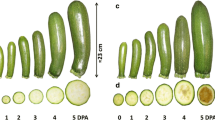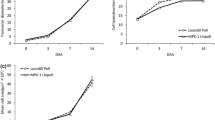Abstract
We examined the effects of seed formation andpara-chlorophenoxyacetic acid (p-CPA)treatment on the growth and endogenous indole acetic acid (IAA) content ofmuskmelon fruit. The growth of parthenocarpic muskmelon fruit induced by 1-(2-chloro-4-pyridyl)-3-phenylurea (CPPU) declined 15 days after anthesis (DAA),resulting in smaller fruit than those pollinated at harvest.p-CPA improved the growth of parthenocarpic fruit thatweretreated between 10 and 25 DAA. Endogenous IAA levels in the seedsof artificially pollinated fruit were at their highest at 10 DAA,then decreased, and increased again after 30 to 45 DAA, whereas,the levels in the empty seeds of parthenocarpic fruit were significantly lowerthroughout development. Although endogenous IAA levels in the placenta ofpollinated fruit were lower than those in the seeds, the changing patterns werevery similar to those in the seeds. Endogenous IAA levels in the mesocarp ofpollinated fruit remained lower than those in the placenta throughout fruitgrowth, and the pattern of change was similar to that of the placenta. Levelsinthe seed, placenta and mesocarp of p-CPA-nontreatedparthenocarpic fruit stayed lower than those in pollinated fruit.p-CPA increased the levels of IAA in the seeds, placenta,and mesocarp of parthenocarpic fruit after the first treatment (10DAA) to 15 DAA, while those in the mesocarp increasedsignificantly after the second treatment (25 DAA), but did notincrease in empty seed and placenta.
Similar content being viewed by others
References
Achhireddy N.R., Kirkwood R.C. and van den Berg G 1984. The development of Pisum sativum explant systems for studies concerning source-sink activities. Physiol. Plant. 61: 130–134.
Crane J.C. 1949. Controlled growth of fig fruits by synthetic hormone applications. Proc. Amer. Soc. Hort. Sci. 54: 102–108.
Gustafson F.G. 1939. Auxin distribution in fruits and its signifi-cance in fruit development. Amer. J. Bot. 26: 189–194.
Hayata Y., Chen L., Niimi Y. and Li X.-X. 2001. p-Chlorophenoxyacetic acid and 1-(2-chloro-4-pyridyl)-3-phenylurea affect growth, sugar contents, and acid contents of cherry tomato fruit with and without pollination. J. Jpn. Soc. Agr. Tech. Man. 8: 13–18.
Hayata Y., Li X.-X., Kishimoto K. and Osajima Y. 2002. p-CPA enhances growth and quality of muskmelon fruits. Plant Growth Regul. 36: 13–18.
Hayata Y., Niimi Y., Inoue K. and Kondo S. 2000. CPPU and BA, with and without pollination affect set, growth and quality of muskmelon fruit (Cucumis melo L.). HortScience 35: 868–870.
Henderson J.H.M. and Deese D.C. 1954. Correlation between endogenous auxin and its destruction in vivo by 2:4-dichlorophenoxyacetic acid in plants. Nature 174: 967–968.
Hocher V., Sotta B., Maldiney R., Bonnet M. and Miginiac E. 1992. Changes in indole-3-acetic acid levels during tomato (Lycopersicon esculentum Mill.) seed development. Plant Cell Rep. 11: 253–256.
Imaseki H. 1991. The biochemistry of ethylene biosynthesis. In: Mattoo A.K. and Suttle J.C. (eds), The Plant Hormone Ethylene. CRC Press, Boca Raton, FL, pp. 1–20.
Katumi M. 1994. Interaction of Plant Hormones. In: Takahashi N. and Fusuda Y. (eds), Plant Hormone Handbook. Baifukan, Tokyo, pp. 241–278, (in Japanese).
Kojima K., Shiozaki K., Koshita Y. and Ishida M. 1999. Changes of endogenous levels of ABA, IAA and GA-like substances in fruitlet of parthenocarpic persimmon. J. Japan Soc. Hort. Sci. 68: 242–247.
Lee T.H., Kato T., Kanayama Y., Ohno H., Takeno K. and Yamaki S. 1997. The role of indole-3-acetic acid and acid invertase in the development of melon (Cucumis melo L. cv. Prince) fruit. J. Japan Soc. Hort. Sci. 65: 723–729.
Li X.-X. 2001. Studies on the role of seed in the growth and quality of melon fruit. PhD Dissertation, Hiroshima Prefectural University, Shobara, Hiroshima.
Li X.-X., Hayata Y. and Osajima Y. 2000. CPPU (re-treatment), p-CPA and NAA improve the growth and quality of parthenocarpic melon fruit induced by CPPU. Environ. Control Biol. 38: 129–134.
Lingle S.E. and Dunlap J.R. 1991. Sucrose metabolism and IAA and ethylene production in muskmelon ovaries. J. Plant Growth Regul. 10: 167–171.
Lis E.K. and Antoszewski R. 1982. Do growth substances regulate the phloem as well as the xylem transport of nutrients to the strawberry receptacle? Planta. 156: 492–495.
Lockhart J.A. and Weintraub R.L. 1953. Influence of 2,4-dichlorophenoxyacetic acid on auxin content of bean seedlings. Amer. J. Bot. 44: 424–428.
Miller A.N. and Walsh C.S. 1990. Indole-3-acetic acid concentration and ethylene evolution during early development in peach. Plant Growth Regul. 9: 37–46.
Nitsch J.P. 1950. Growth and morphogenesis of the strawberry as related to auxin. Amer. J. Bot. 37: 211–215.
Sara E.L. and Dunlap J.R. 1991. Sucrose metabolism and IAA and ethylene production in muskmelon ovaries. J. Plant Growth Regul. 10: 167–171.
Takeno C. and Ise H. 1992. Parthenocarpic fruit set and endogenous indole-3-acetic acid content in ovary of Cucumis sativus L. J. Japan Soc. Hort. Sci. 60: 941–946.
Xu X., Kato T., Fukumoto Y., Nakajima Y. and Zhong L. 1989. Changes in endogenous hormone levels of watermelon and muskmelon fruits during development. Bull Res. Inst. System Hort. Fac. Agric. Kochi. Univ. 6: 15–21.
Author information
Authors and Affiliations
Corresponding author
Rights and permissions
About this article
Cite this article
Li, XX., Hayata, Y. & Osajima, Y. p-CPA increases the endogenous IAA content of parthenocarpic muskmelon fruit. Plant Growth Regulation 37, 99–103 (2002). https://doi.org/10.1023/A:1020580427010
Issue Date:
DOI: https://doi.org/10.1023/A:1020580427010




